Strategic Change Management Analysis: Woolworths' Operations
VerifiedAdded on 2022/10/04
|10
|2627
|66
Report
AI Summary
This report provides a comprehensive analysis of Woolworths' change management strategies. It begins with an introduction highlighting the increasing competition and the need for innovative strategies to enhance customer satisfaction. The report delves into Woolworths' current strategies, including restructuring, personalized customer experiences, and technological advancements such as AI-driven product tracking and Wi-Fi upgrades. It examines both internal factors, such as workforce dynamics, and external factors, like technological advancements and government regulations, that drive the need for change. The McKinsey 7S model is applied to assess Woolworths' approach to structure, systems, and strategies. Human resource strategies, including training programs and reward systems, are discussed in relation to employee satisfaction and retention. Finally, the report explores the integration of future strategies, like the lean retail model and the use of AI, to achieve strategic goals and concludes with a self-reflection on the importance of innovation and change management for sustained business success.
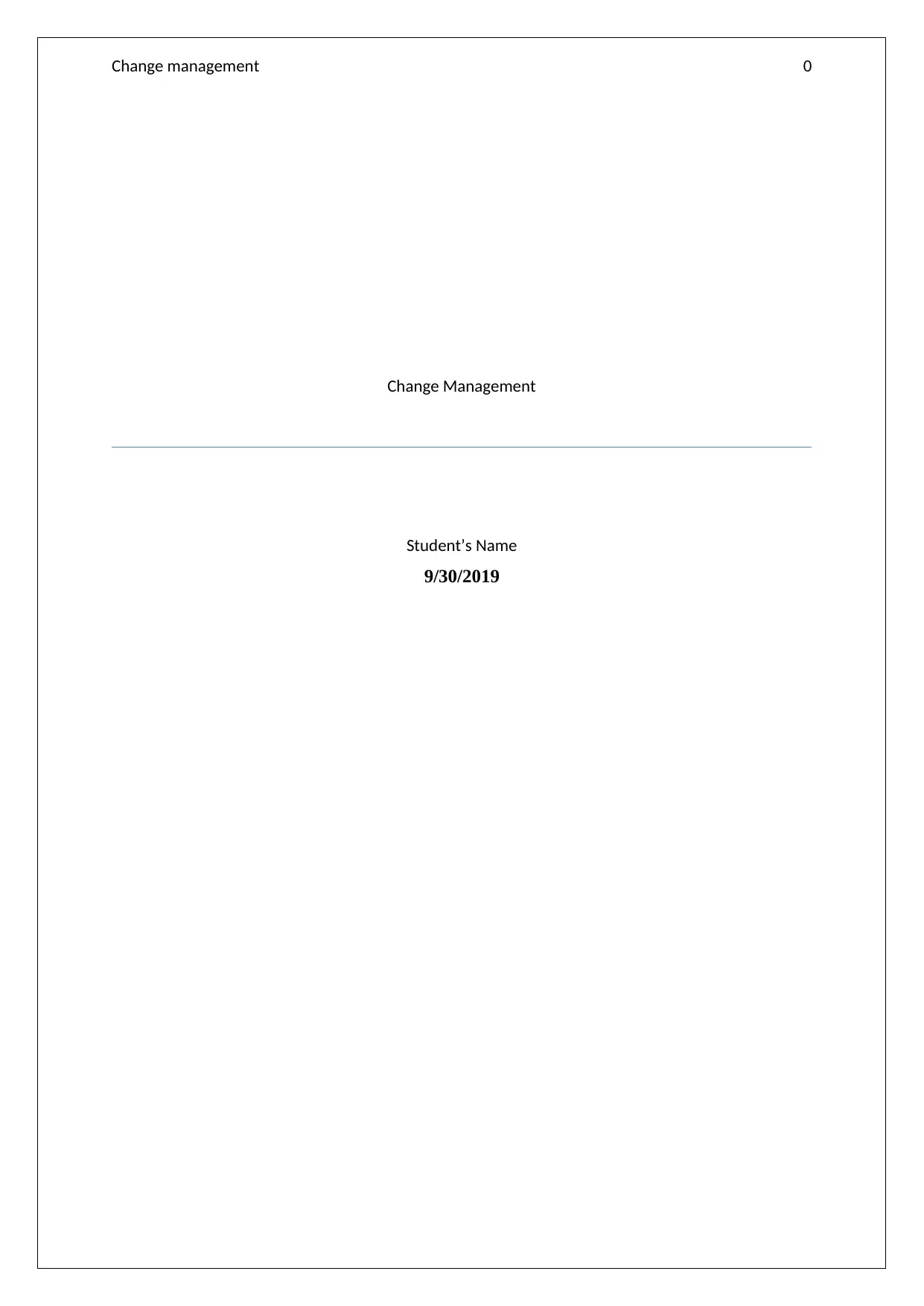
Change management 0
Change Management
Student’s Name
9/30/2019
Change Management
Student’s Name
9/30/2019
Paraphrase This Document
Need a fresh take? Get an instant paraphrase of this document with our AI Paraphraser
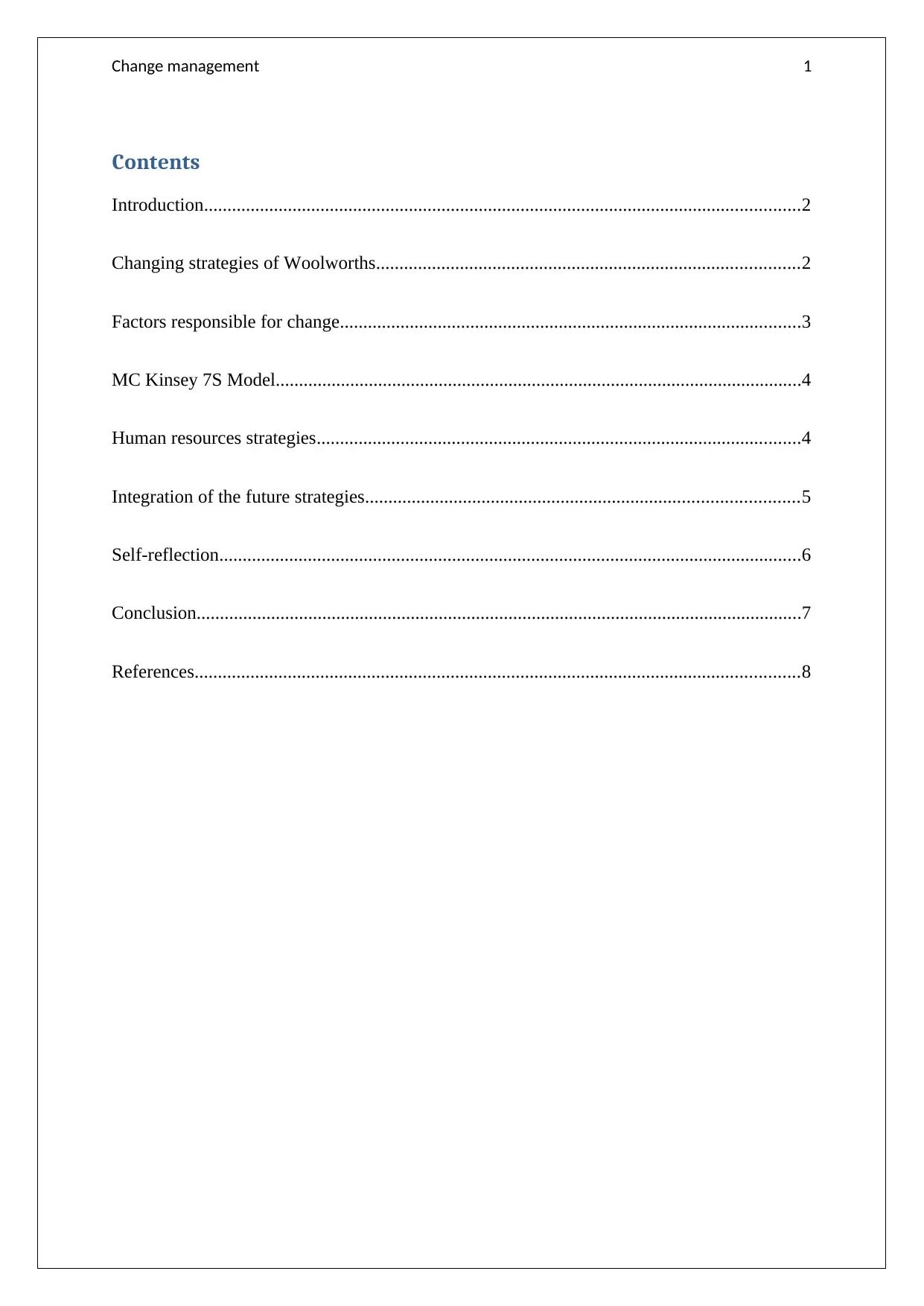
Change management 1
Contents
Introduction................................................................................................................................2
Changing strategies of Woolworths...........................................................................................2
Factors responsible for change...................................................................................................3
MC Kinsey 7S Model.................................................................................................................4
Human resources strategies........................................................................................................4
Integration of the future strategies.............................................................................................5
Self-reflection.............................................................................................................................6
Conclusion..................................................................................................................................7
References..................................................................................................................................8
Contents
Introduction................................................................................................................................2
Changing strategies of Woolworths...........................................................................................2
Factors responsible for change...................................................................................................3
MC Kinsey 7S Model.................................................................................................................4
Human resources strategies........................................................................................................4
Integration of the future strategies.............................................................................................5
Self-reflection.............................................................................................................................6
Conclusion..................................................................................................................................7
References..................................................................................................................................8
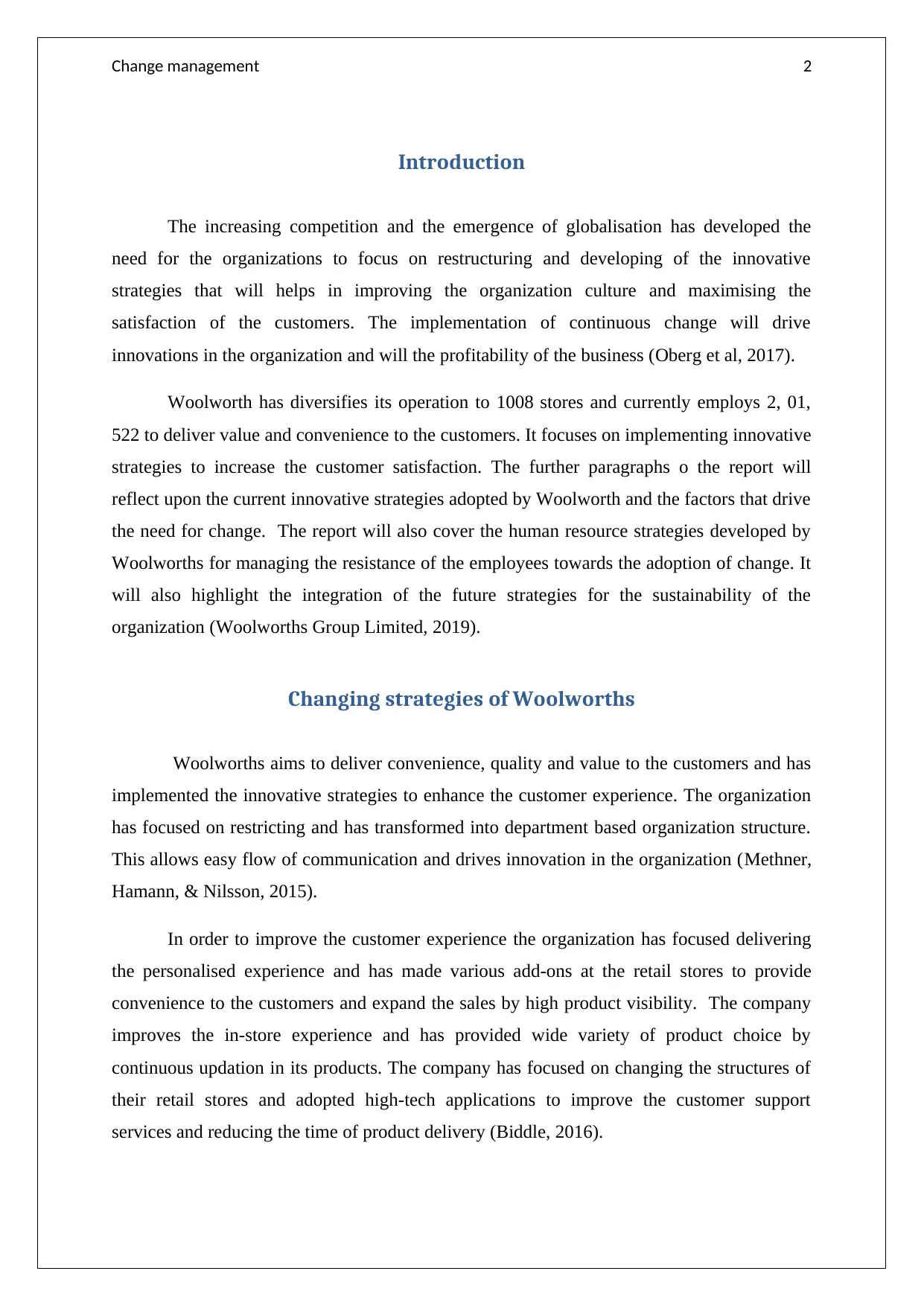
Change management 2
Introduction
The increasing competition and the emergence of globalisation has developed the
need for the organizations to focus on restructuring and developing of the innovative
strategies that will helps in improving the organization culture and maximising the
satisfaction of the customers. The implementation of continuous change will drive
innovations in the organization and will the profitability of the business (Oberg et al, 2017).
Woolworth has diversifies its operation to 1008 stores and currently employs 2, 01,
522 to deliver value and convenience to the customers. It focuses on implementing innovative
strategies to increase the customer satisfaction. The further paragraphs o the report will
reflect upon the current innovative strategies adopted by Woolworth and the factors that drive
the need for change. The report will also cover the human resource strategies developed by
Woolworths for managing the resistance of the employees towards the adoption of change. It
will also highlight the integration of the future strategies for the sustainability of the
organization (Woolworths Group Limited, 2019).
Changing strategies of Woolworths
Woolworths aims to deliver convenience, quality and value to the customers and has
implemented the innovative strategies to enhance the customer experience. The organization
has focused on restricting and has transformed into department based organization structure.
This allows easy flow of communication and drives innovation in the organization (Methner,
Hamann, & Nilsson, 2015).
In order to improve the customer experience the organization has focused delivering
the personalised experience and has made various add-ons at the retail stores to provide
convenience to the customers and expand the sales by high product visibility. The company
improves the in-store experience and has provided wide variety of product choice by
continuous updation in its products. The company has focused on changing the structures of
their retail stores and adopted high-tech applications to improve the customer support
services and reducing the time of product delivery (Biddle, 2016).
Introduction
The increasing competition and the emergence of globalisation has developed the
need for the organizations to focus on restructuring and developing of the innovative
strategies that will helps in improving the organization culture and maximising the
satisfaction of the customers. The implementation of continuous change will drive
innovations in the organization and will the profitability of the business (Oberg et al, 2017).
Woolworth has diversifies its operation to 1008 stores and currently employs 2, 01,
522 to deliver value and convenience to the customers. It focuses on implementing innovative
strategies to increase the customer satisfaction. The further paragraphs o the report will
reflect upon the current innovative strategies adopted by Woolworth and the factors that drive
the need for change. The report will also cover the human resource strategies developed by
Woolworths for managing the resistance of the employees towards the adoption of change. It
will also highlight the integration of the future strategies for the sustainability of the
organization (Woolworths Group Limited, 2019).
Changing strategies of Woolworths
Woolworths aims to deliver convenience, quality and value to the customers and has
implemented the innovative strategies to enhance the customer experience. The organization
has focused on restricting and has transformed into department based organization structure.
This allows easy flow of communication and drives innovation in the organization (Methner,
Hamann, & Nilsson, 2015).
In order to improve the customer experience the organization has focused delivering
the personalised experience and has made various add-ons at the retail stores to provide
convenience to the customers and expand the sales by high product visibility. The company
improves the in-store experience and has provided wide variety of product choice by
continuous updation in its products. The company has focused on changing the structures of
their retail stores and adopted high-tech applications to improve the customer support
services and reducing the time of product delivery (Biddle, 2016).
⊘ This is a preview!⊘
Do you want full access?
Subscribe today to unlock all pages.

Trusted by 1+ million students worldwide
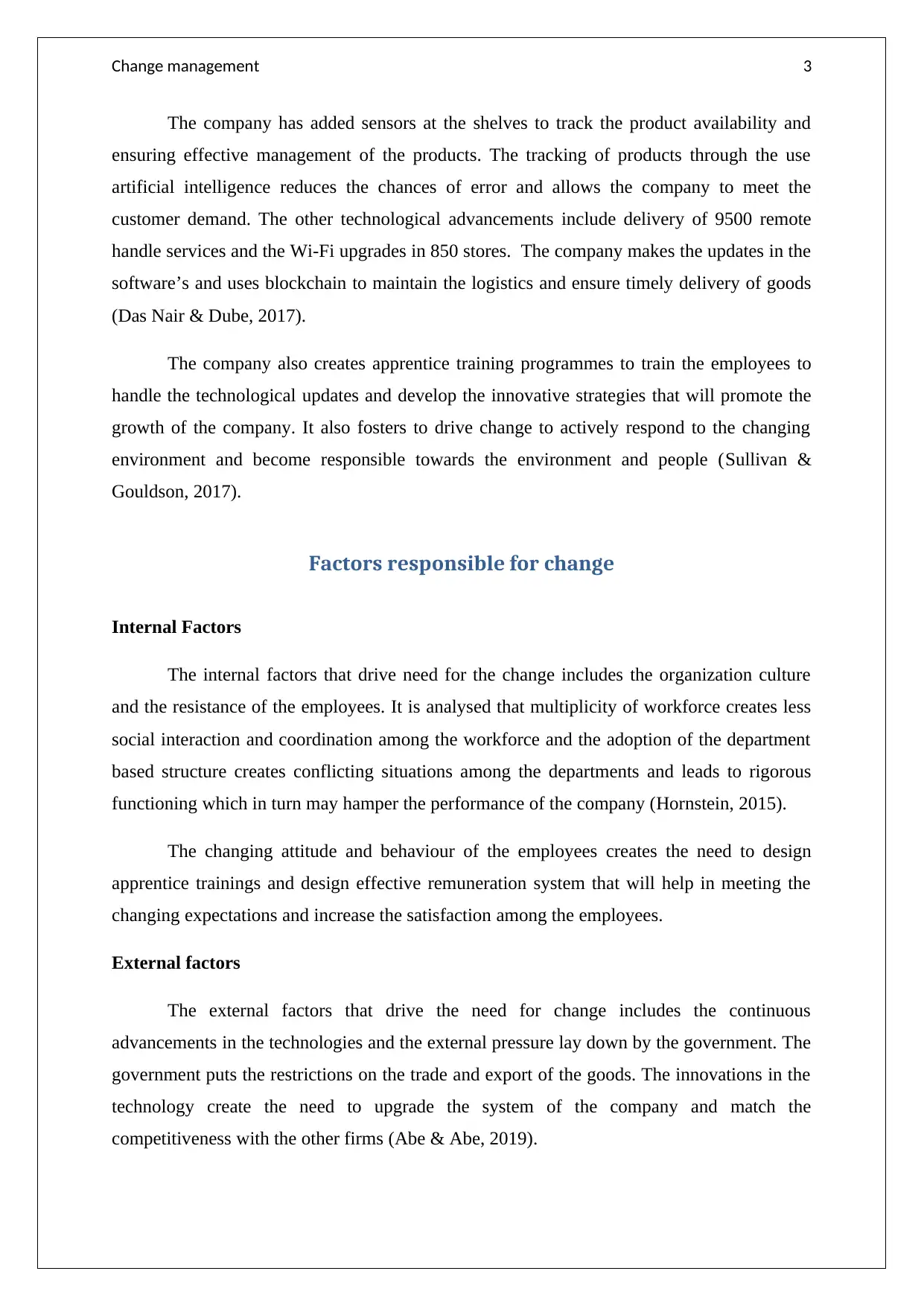
Change management 3
The company has added sensors at the shelves to track the product availability and
ensuring effective management of the products. The tracking of products through the use
artificial intelligence reduces the chances of error and allows the company to meet the
customer demand. The other technological advancements include delivery of 9500 remote
handle services and the Wi-Fi upgrades in 850 stores. The company makes the updates in the
software’s and uses blockchain to maintain the logistics and ensure timely delivery of goods
(Das Nair & Dube, 2017).
The company also creates apprentice training programmes to train the employees to
handle the technological updates and develop the innovative strategies that will promote the
growth of the company. It also fosters to drive change to actively respond to the changing
environment and become responsible towards the environment and people (Sullivan &
Gouldson, 2017).
Factors responsible for change
Internal Factors
The internal factors that drive need for the change includes the organization culture
and the resistance of the employees. It is analysed that multiplicity of workforce creates less
social interaction and coordination among the workforce and the adoption of the department
based structure creates conflicting situations among the departments and leads to rigorous
functioning which in turn may hamper the performance of the company (Hornstein, 2015).
The changing attitude and behaviour of the employees creates the need to design
apprentice trainings and design effective remuneration system that will help in meeting the
changing expectations and increase the satisfaction among the employees.
External factors
The external factors that drive the need for change includes the continuous
advancements in the technologies and the external pressure lay down by the government. The
government puts the restrictions on the trade and export of the goods. The innovations in the
technology create the need to upgrade the system of the company and match the
competitiveness with the other firms (Abe & Abe, 2019).
The company has added sensors at the shelves to track the product availability and
ensuring effective management of the products. The tracking of products through the use
artificial intelligence reduces the chances of error and allows the company to meet the
customer demand. The other technological advancements include delivery of 9500 remote
handle services and the Wi-Fi upgrades in 850 stores. The company makes the updates in the
software’s and uses blockchain to maintain the logistics and ensure timely delivery of goods
(Das Nair & Dube, 2017).
The company also creates apprentice training programmes to train the employees to
handle the technological updates and develop the innovative strategies that will promote the
growth of the company. It also fosters to drive change to actively respond to the changing
environment and become responsible towards the environment and people (Sullivan &
Gouldson, 2017).
Factors responsible for change
Internal Factors
The internal factors that drive need for the change includes the organization culture
and the resistance of the employees. It is analysed that multiplicity of workforce creates less
social interaction and coordination among the workforce and the adoption of the department
based structure creates conflicting situations among the departments and leads to rigorous
functioning which in turn may hamper the performance of the company (Hornstein, 2015).
The changing attitude and behaviour of the employees creates the need to design
apprentice trainings and design effective remuneration system that will help in meeting the
changing expectations and increase the satisfaction among the employees.
External factors
The external factors that drive the need for change includes the continuous
advancements in the technologies and the external pressure lay down by the government. The
government puts the restrictions on the trade and export of the goods. The innovations in the
technology create the need to upgrade the system of the company and match the
competitiveness with the other firms (Abe & Abe, 2019).
Paraphrase This Document
Need a fresh take? Get an instant paraphrase of this document with our AI Paraphraser
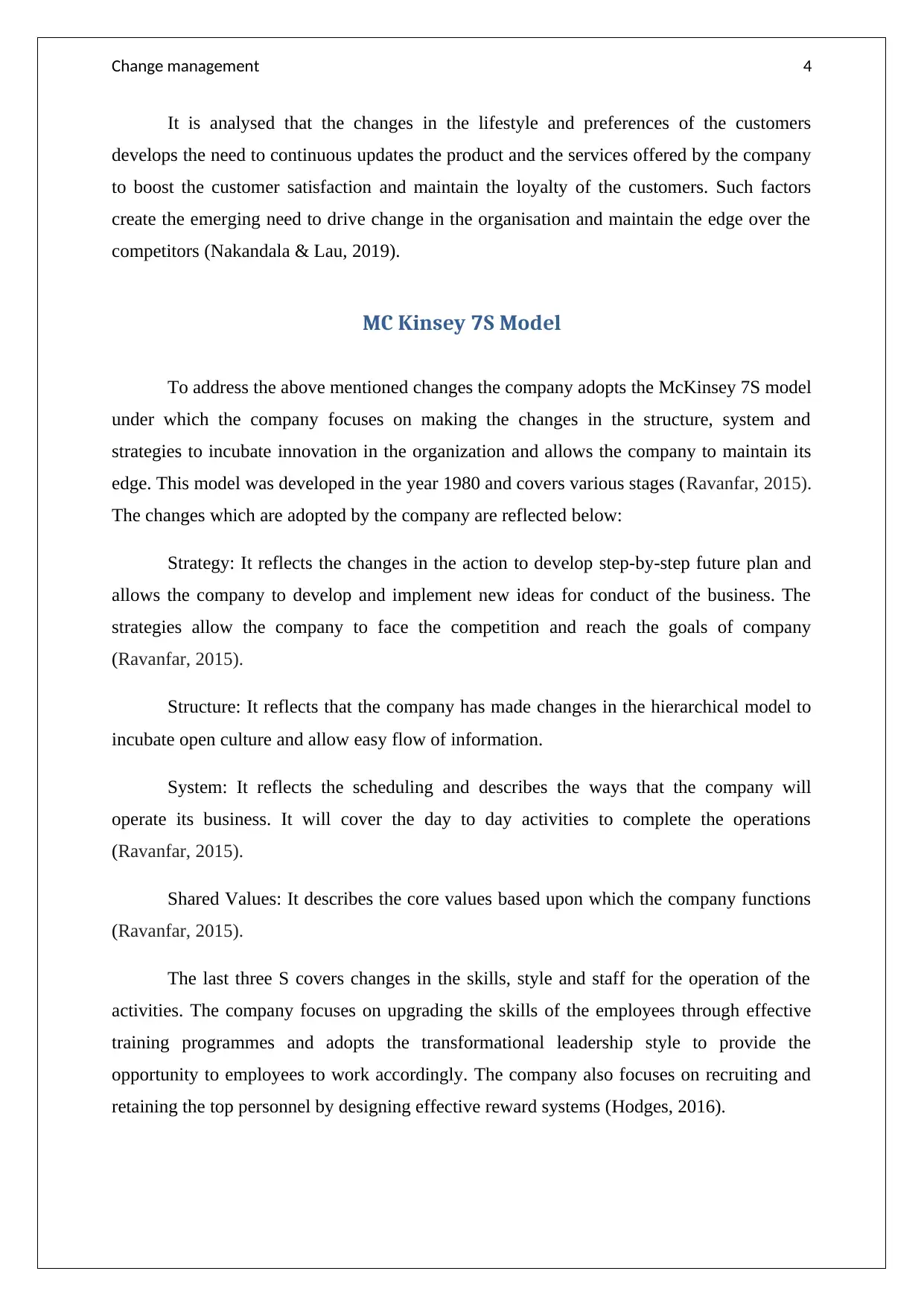
Change management 4
It is analysed that the changes in the lifestyle and preferences of the customers
develops the need to continuous updates the product and the services offered by the company
to boost the customer satisfaction and maintain the loyalty of the customers. Such factors
create the emerging need to drive change in the organisation and maintain the edge over the
competitors (Nakandala & Lau, 2019).
MC Kinsey 7S Model
To address the above mentioned changes the company adopts the McKinsey 7S model
under which the company focuses on making the changes in the structure, system and
strategies to incubate innovation in the organization and allows the company to maintain its
edge. This model was developed in the year 1980 and covers various stages (Ravanfar, 2015).
The changes which are adopted by the company are reflected below:
Strategy: It reflects the changes in the action to develop step-by-step future plan and
allows the company to develop and implement new ideas for conduct of the business. The
strategies allow the company to face the competition and reach the goals of company
(Ravanfar, 2015).
Structure: It reflects that the company has made changes in the hierarchical model to
incubate open culture and allow easy flow of information.
System: It reflects the scheduling and describes the ways that the company will
operate its business. It will cover the day to day activities to complete the operations
(Ravanfar, 2015).
Shared Values: It describes the core values based upon which the company functions
(Ravanfar, 2015).
The last three S covers changes in the skills, style and staff for the operation of the
activities. The company focuses on upgrading the skills of the employees through effective
training programmes and adopts the transformational leadership style to provide the
opportunity to employees to work accordingly. The company also focuses on recruiting and
retaining the top personnel by designing effective reward systems (Hodges, 2016).
It is analysed that the changes in the lifestyle and preferences of the customers
develops the need to continuous updates the product and the services offered by the company
to boost the customer satisfaction and maintain the loyalty of the customers. Such factors
create the emerging need to drive change in the organisation and maintain the edge over the
competitors (Nakandala & Lau, 2019).
MC Kinsey 7S Model
To address the above mentioned changes the company adopts the McKinsey 7S model
under which the company focuses on making the changes in the structure, system and
strategies to incubate innovation in the organization and allows the company to maintain its
edge. This model was developed in the year 1980 and covers various stages (Ravanfar, 2015).
The changes which are adopted by the company are reflected below:
Strategy: It reflects the changes in the action to develop step-by-step future plan and
allows the company to develop and implement new ideas for conduct of the business. The
strategies allow the company to face the competition and reach the goals of company
(Ravanfar, 2015).
Structure: It reflects that the company has made changes in the hierarchical model to
incubate open culture and allow easy flow of information.
System: It reflects the scheduling and describes the ways that the company will
operate its business. It will cover the day to day activities to complete the operations
(Ravanfar, 2015).
Shared Values: It describes the core values based upon which the company functions
(Ravanfar, 2015).
The last three S covers changes in the skills, style and staff for the operation of the
activities. The company focuses on upgrading the skills of the employees through effective
training programmes and adopts the transformational leadership style to provide the
opportunity to employees to work accordingly. The company also focuses on recruiting and
retaining the top personnel by designing effective reward systems (Hodges, 2016).
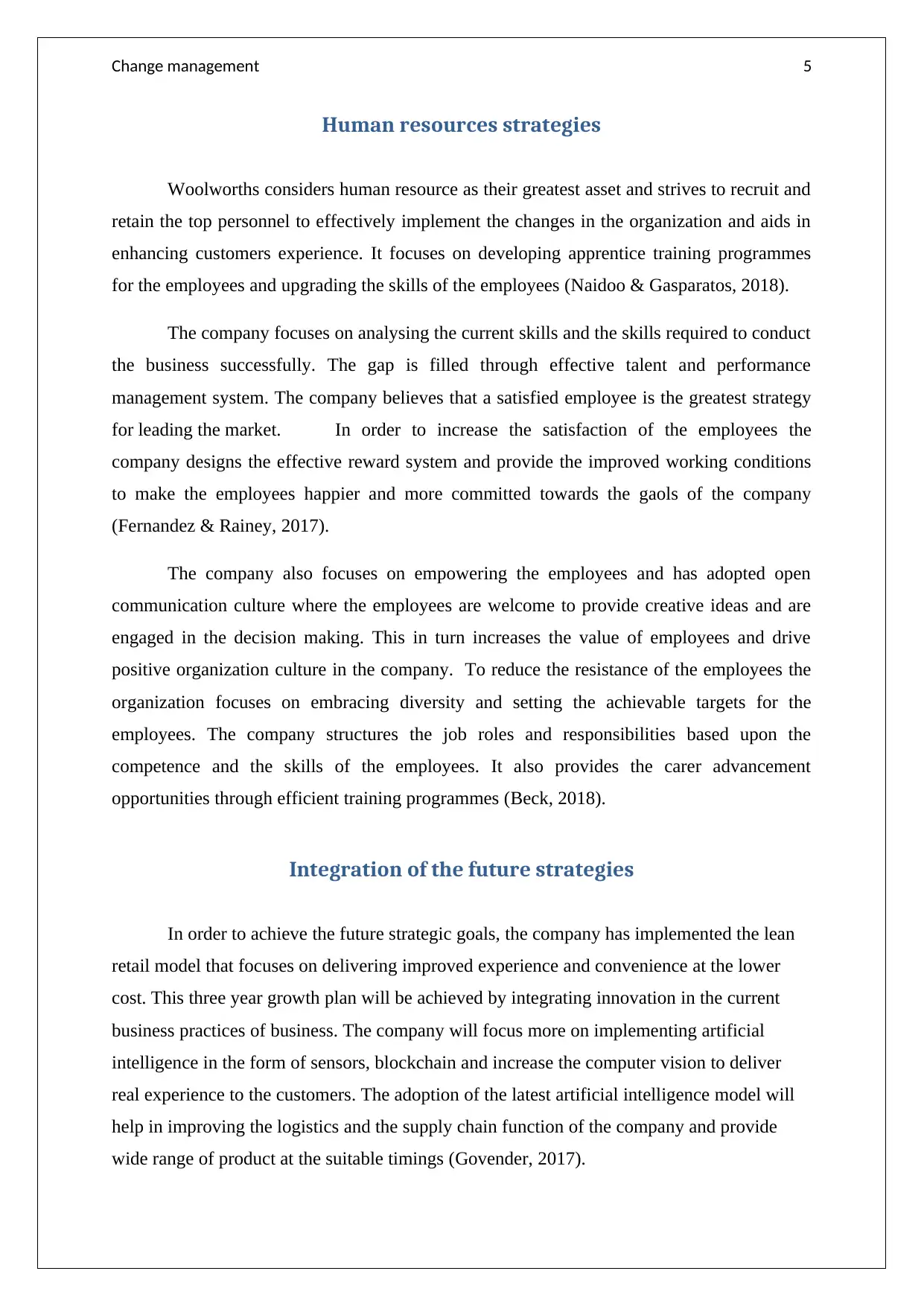
Change management 5
Human resources strategies
Woolworths considers human resource as their greatest asset and strives to recruit and
retain the top personnel to effectively implement the changes in the organization and aids in
enhancing customers experience. It focuses on developing apprentice training programmes
for the employees and upgrading the skills of the employees (Naidoo & Gasparatos, 2018).
The company focuses on analysing the current skills and the skills required to conduct
the business successfully. The gap is filled through effective talent and performance
management system. The company believes that a satisfied employee is the greatest strategy
for leading the market. In order to increase the satisfaction of the employees the
company designs the effective reward system and provide the improved working conditions
to make the employees happier and more committed towards the gaols of the company
(Fernandez & Rainey, 2017).
The company also focuses on empowering the employees and has adopted open
communication culture where the employees are welcome to provide creative ideas and are
engaged in the decision making. This in turn increases the value of employees and drive
positive organization culture in the company. To reduce the resistance of the employees the
organization focuses on embracing diversity and setting the achievable targets for the
employees. The company structures the job roles and responsibilities based upon the
competence and the skills of the employees. It also provides the carer advancement
opportunities through efficient training programmes (Beck, 2018).
Integration of the future strategies
In order to achieve the future strategic goals, the company has implemented the lean
retail model that focuses on delivering improved experience and convenience at the lower
cost. This three year growth plan will be achieved by integrating innovation in the current
business practices of business. The company will focus more on implementing artificial
intelligence in the form of sensors, blockchain and increase the computer vision to deliver
real experience to the customers. The adoption of the latest artificial intelligence model will
help in improving the logistics and the supply chain function of the company and provide
wide range of product at the suitable timings (Govender, 2017).
Human resources strategies
Woolworths considers human resource as their greatest asset and strives to recruit and
retain the top personnel to effectively implement the changes in the organization and aids in
enhancing customers experience. It focuses on developing apprentice training programmes
for the employees and upgrading the skills of the employees (Naidoo & Gasparatos, 2018).
The company focuses on analysing the current skills and the skills required to conduct
the business successfully. The gap is filled through effective talent and performance
management system. The company believes that a satisfied employee is the greatest strategy
for leading the market. In order to increase the satisfaction of the employees the
company designs the effective reward system and provide the improved working conditions
to make the employees happier and more committed towards the gaols of the company
(Fernandez & Rainey, 2017).
The company also focuses on empowering the employees and has adopted open
communication culture where the employees are welcome to provide creative ideas and are
engaged in the decision making. This in turn increases the value of employees and drive
positive organization culture in the company. To reduce the resistance of the employees the
organization focuses on embracing diversity and setting the achievable targets for the
employees. The company structures the job roles and responsibilities based upon the
competence and the skills of the employees. It also provides the carer advancement
opportunities through efficient training programmes (Beck, 2018).
Integration of the future strategies
In order to achieve the future strategic goals, the company has implemented the lean
retail model that focuses on delivering improved experience and convenience at the lower
cost. This three year growth plan will be achieved by integrating innovation in the current
business practices of business. The company will focus more on implementing artificial
intelligence in the form of sensors, blockchain and increase the computer vision to deliver
real experience to the customers. The adoption of the latest artificial intelligence model will
help in improving the logistics and the supply chain function of the company and provide
wide range of product at the suitable timings (Govender, 2017).
⊘ This is a preview!⊘
Do you want full access?
Subscribe today to unlock all pages.

Trusted by 1+ million students worldwide
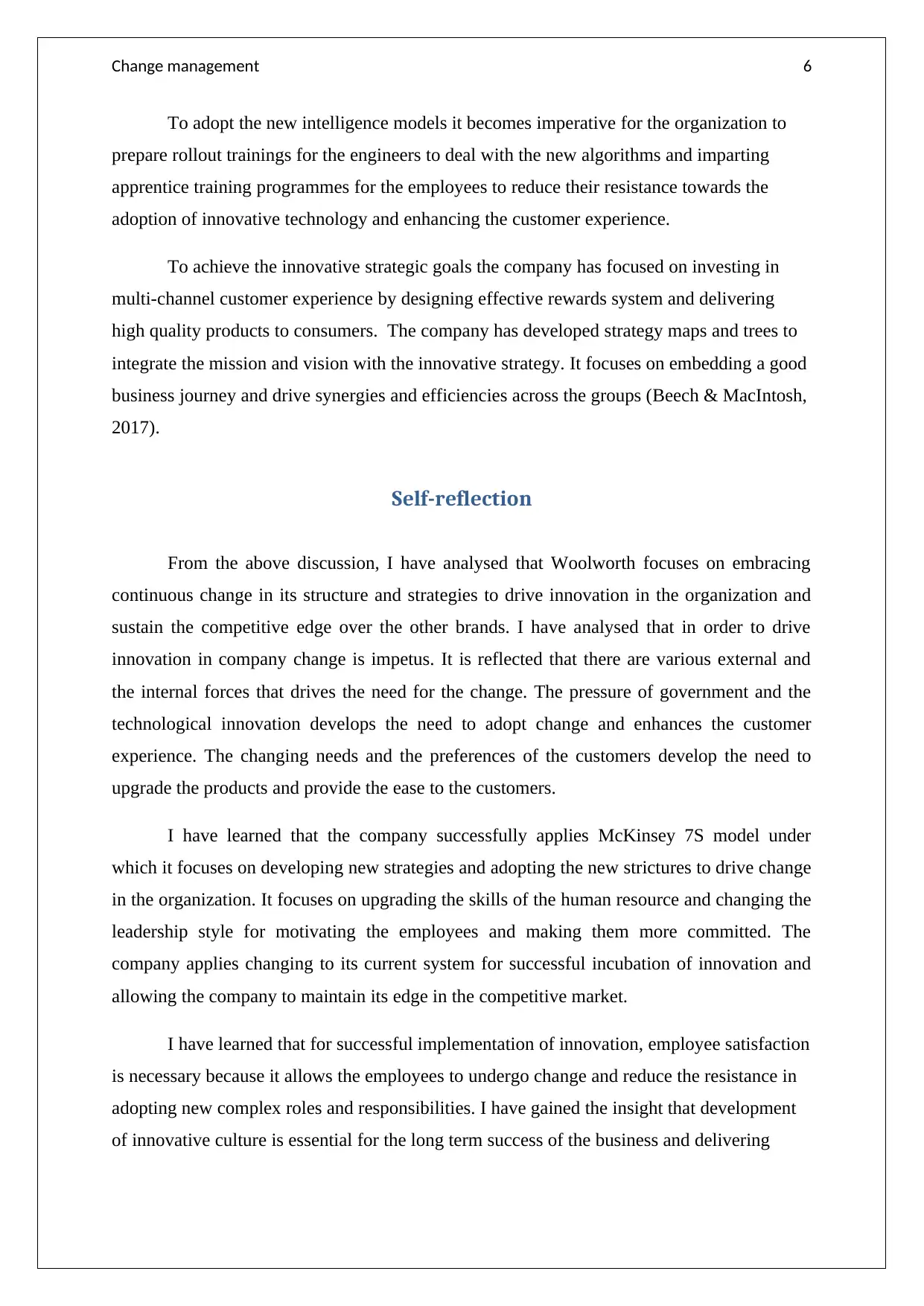
Change management 6
To adopt the new intelligence models it becomes imperative for the organization to
prepare rollout trainings for the engineers to deal with the new algorithms and imparting
apprentice training programmes for the employees to reduce their resistance towards the
adoption of innovative technology and enhancing the customer experience.
To achieve the innovative strategic goals the company has focused on investing in
multi-channel customer experience by designing effective rewards system and delivering
high quality products to consumers. The company has developed strategy maps and trees to
integrate the mission and vision with the innovative strategy. It focuses on embedding a good
business journey and drive synergies and efficiencies across the groups (Beech & MacIntosh,
2017).
Self-reflection
From the above discussion, I have analysed that Woolworth focuses on embracing
continuous change in its structure and strategies to drive innovation in the organization and
sustain the competitive edge over the other brands. I have analysed that in order to drive
innovation in company change is impetus. It is reflected that there are various external and
the internal forces that drives the need for the change. The pressure of government and the
technological innovation develops the need to adopt change and enhances the customer
experience. The changing needs and the preferences of the customers develop the need to
upgrade the products and provide the ease to the customers.
I have learned that the company successfully applies McKinsey 7S model under
which it focuses on developing new strategies and adopting the new strictures to drive change
in the organization. It focuses on upgrading the skills of the human resource and changing the
leadership style for motivating the employees and making them more committed. The
company applies changing to its current system for successful incubation of innovation and
allowing the company to maintain its edge in the competitive market.
I have learned that for successful implementation of innovation, employee satisfaction
is necessary because it allows the employees to undergo change and reduce the resistance in
adopting new complex roles and responsibilities. I have gained the insight that development
of innovative culture is essential for the long term success of the business and delivering
To adopt the new intelligence models it becomes imperative for the organization to
prepare rollout trainings for the engineers to deal with the new algorithms and imparting
apprentice training programmes for the employees to reduce their resistance towards the
adoption of innovative technology and enhancing the customer experience.
To achieve the innovative strategic goals the company has focused on investing in
multi-channel customer experience by designing effective rewards system and delivering
high quality products to consumers. The company has developed strategy maps and trees to
integrate the mission and vision with the innovative strategy. It focuses on embedding a good
business journey and drive synergies and efficiencies across the groups (Beech & MacIntosh,
2017).
Self-reflection
From the above discussion, I have analysed that Woolworth focuses on embracing
continuous change in its structure and strategies to drive innovation in the organization and
sustain the competitive edge over the other brands. I have analysed that in order to drive
innovation in company change is impetus. It is reflected that there are various external and
the internal forces that drives the need for the change. The pressure of government and the
technological innovation develops the need to adopt change and enhances the customer
experience. The changing needs and the preferences of the customers develop the need to
upgrade the products and provide the ease to the customers.
I have learned that the company successfully applies McKinsey 7S model under
which it focuses on developing new strategies and adopting the new strictures to drive change
in the organization. It focuses on upgrading the skills of the human resource and changing the
leadership style for motivating the employees and making them more committed. The
company applies changing to its current system for successful incubation of innovation and
allowing the company to maintain its edge in the competitive market.
I have learned that for successful implementation of innovation, employee satisfaction
is necessary because it allows the employees to undergo change and reduce the resistance in
adopting new complex roles and responsibilities. I have gained the insight that development
of innovative culture is essential for the long term success of the business and delivering
Paraphrase This Document
Need a fresh take? Get an instant paraphrase of this document with our AI Paraphraser
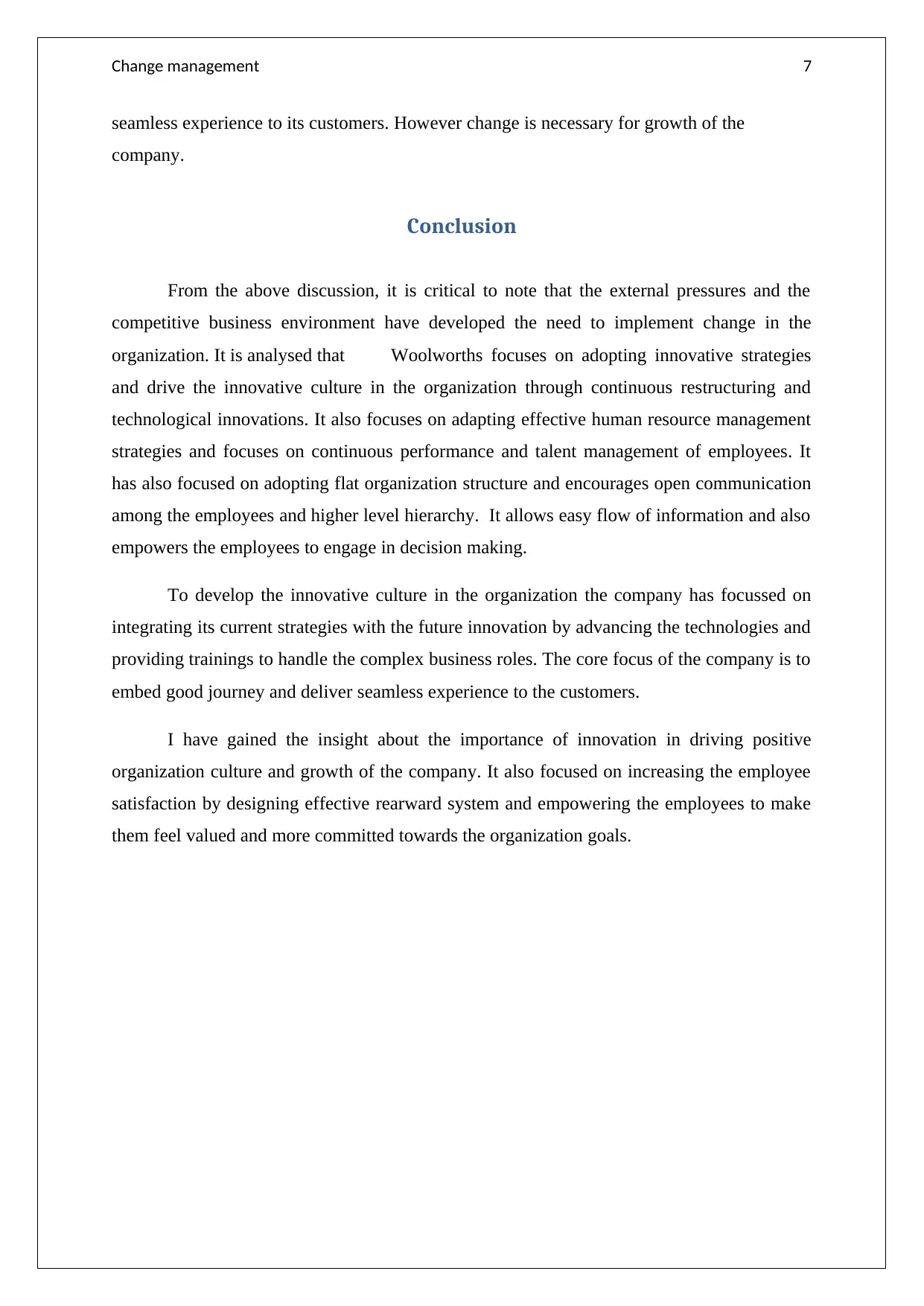
Change management 7
seamless experience to its customers. However change is necessary for growth of the
company.
Conclusion
From the above discussion, it is critical to note that the external pressures and the
competitive business environment have developed the need to implement change in the
organization. It is analysed that Woolworths focuses on adopting innovative strategies
and drive the innovative culture in the organization through continuous restructuring and
technological innovations. It also focuses on adapting effective human resource management
strategies and focuses on continuous performance and talent management of employees. It
has also focused on adopting flat organization structure and encourages open communication
among the employees and higher level hierarchy. It allows easy flow of information and also
empowers the employees to engage in decision making.
To develop the innovative culture in the organization the company has focussed on
integrating its current strategies with the future innovation by advancing the technologies and
providing trainings to handle the complex business roles. The core focus of the company is to
embed good journey and deliver seamless experience to the customers.
I have gained the insight about the importance of innovation in driving positive
organization culture and growth of the company. It also focused on increasing the employee
satisfaction by designing effective rearward system and empowering the employees to make
them feel valued and more committed towards the organization goals.
seamless experience to its customers. However change is necessary for growth of the
company.
Conclusion
From the above discussion, it is critical to note that the external pressures and the
competitive business environment have developed the need to implement change in the
organization. It is analysed that Woolworths focuses on adopting innovative strategies
and drive the innovative culture in the organization through continuous restructuring and
technological innovations. It also focuses on adapting effective human resource management
strategies and focuses on continuous performance and talent management of employees. It
has also focused on adopting flat organization structure and encourages open communication
among the employees and higher level hierarchy. It allows easy flow of information and also
empowers the employees to engage in decision making.
To develop the innovative culture in the organization the company has focussed on
integrating its current strategies with the future innovation by advancing the technologies and
providing trainings to handle the complex business roles. The core focus of the company is to
embed good journey and deliver seamless experience to the customers.
I have gained the insight about the importance of innovation in driving positive
organization culture and growth of the company. It also focused on increasing the employee
satisfaction by designing effective rearward system and empowering the employees to make
them feel valued and more committed towards the organization goals.
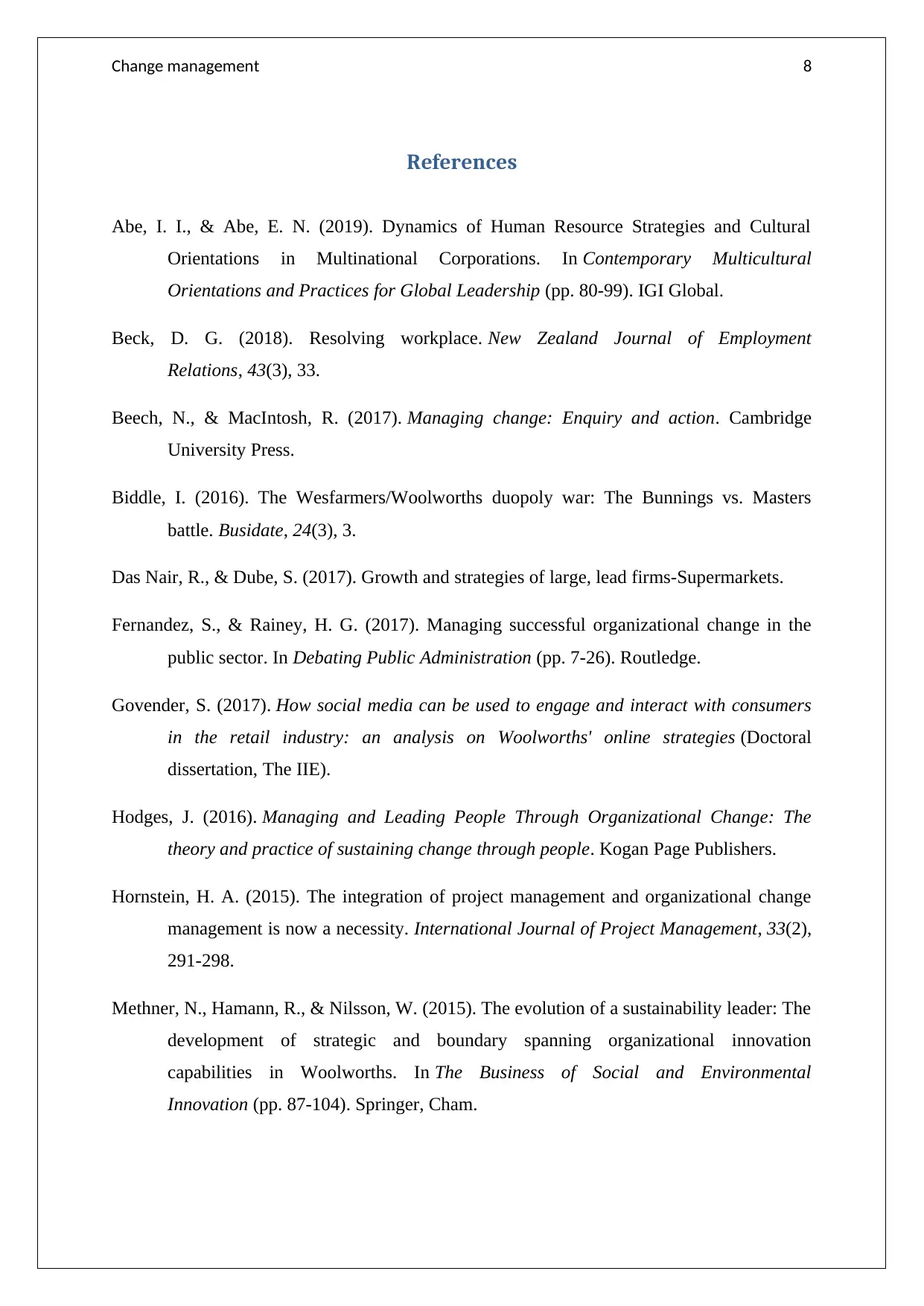
Change management 8
References
Abe, I. I., & Abe, E. N. (2019). Dynamics of Human Resource Strategies and Cultural
Orientations in Multinational Corporations. In Contemporary Multicultural
Orientations and Practices for Global Leadership (pp. 80-99). IGI Global.
Beck, D. G. (2018). Resolving workplace. New Zealand Journal of Employment
Relations, 43(3), 33.
Beech, N., & MacIntosh, R. (2017). Managing change: Enquiry and action. Cambridge
University Press.
Biddle, I. (2016). The Wesfarmers/Woolworths duopoly war: The Bunnings vs. Masters
battle. Busidate, 24(3), 3.
Das Nair, R., & Dube, S. (2017). Growth and strategies of large, lead firms-Supermarkets.
Fernandez, S., & Rainey, H. G. (2017). Managing successful organizational change in the
public sector. In Debating Public Administration (pp. 7-26). Routledge.
Govender, S. (2017). How social media can be used to engage and interact with consumers
in the retail industry: an analysis on Woolworths' online strategies (Doctoral
dissertation, The IIE).
Hodges, J. (2016). Managing and Leading People Through Organizational Change: The
theory and practice of sustaining change through people. Kogan Page Publishers.
Hornstein, H. A. (2015). The integration of project management and organizational change
management is now a necessity. International Journal of Project Management, 33(2),
291-298.
Methner, N., Hamann, R., & Nilsson, W. (2015). The evolution of a sustainability leader: The
development of strategic and boundary spanning organizational innovation
capabilities in Woolworths. In The Business of Social and Environmental
Innovation (pp. 87-104). Springer, Cham.
References
Abe, I. I., & Abe, E. N. (2019). Dynamics of Human Resource Strategies and Cultural
Orientations in Multinational Corporations. In Contemporary Multicultural
Orientations and Practices for Global Leadership (pp. 80-99). IGI Global.
Beck, D. G. (2018). Resolving workplace. New Zealand Journal of Employment
Relations, 43(3), 33.
Beech, N., & MacIntosh, R. (2017). Managing change: Enquiry and action. Cambridge
University Press.
Biddle, I. (2016). The Wesfarmers/Woolworths duopoly war: The Bunnings vs. Masters
battle. Busidate, 24(3), 3.
Das Nair, R., & Dube, S. (2017). Growth and strategies of large, lead firms-Supermarkets.
Fernandez, S., & Rainey, H. G. (2017). Managing successful organizational change in the
public sector. In Debating Public Administration (pp. 7-26). Routledge.
Govender, S. (2017). How social media can be used to engage and interact with consumers
in the retail industry: an analysis on Woolworths' online strategies (Doctoral
dissertation, The IIE).
Hodges, J. (2016). Managing and Leading People Through Organizational Change: The
theory and practice of sustaining change through people. Kogan Page Publishers.
Hornstein, H. A. (2015). The integration of project management and organizational change
management is now a necessity. International Journal of Project Management, 33(2),
291-298.
Methner, N., Hamann, R., & Nilsson, W. (2015). The evolution of a sustainability leader: The
development of strategic and boundary spanning organizational innovation
capabilities in Woolworths. In The Business of Social and Environmental
Innovation (pp. 87-104). Springer, Cham.
⊘ This is a preview!⊘
Do you want full access?
Subscribe today to unlock all pages.

Trusted by 1+ million students worldwide
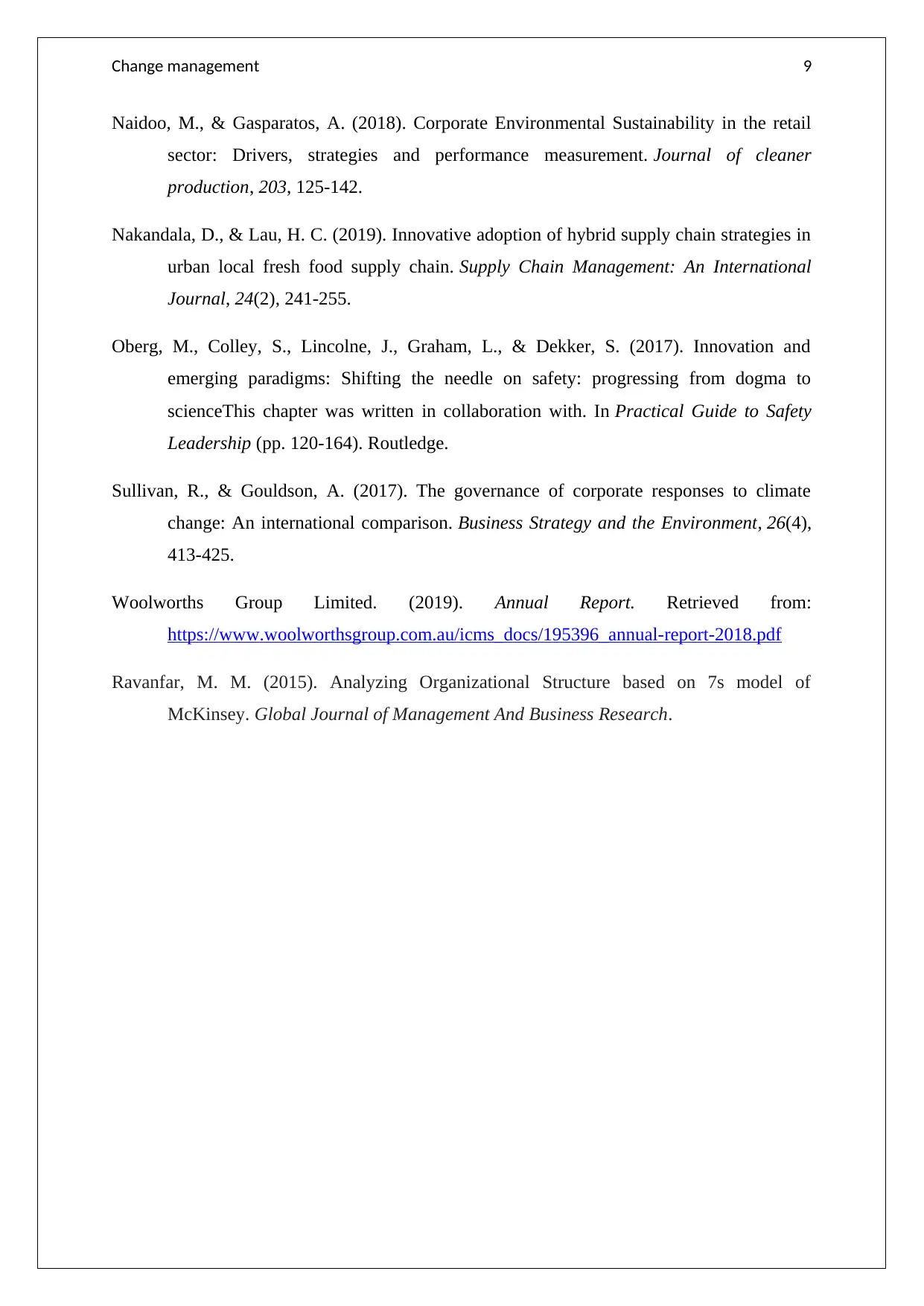
Change management 9
Naidoo, M., & Gasparatos, A. (2018). Corporate Environmental Sustainability in the retail
sector: Drivers, strategies and performance measurement. Journal of cleaner
production, 203, 125-142.
Nakandala, D., & Lau, H. C. (2019). Innovative adoption of hybrid supply chain strategies in
urban local fresh food supply chain. Supply Chain Management: An International
Journal, 24(2), 241-255.
Oberg, M., Colley, S., Lincolne, J., Graham, L., & Dekker, S. (2017). Innovation and
emerging paradigms: Shifting the needle on safety: progressing from dogma to
scienceThis chapter was written in collaboration with. In Practical Guide to Safety
Leadership (pp. 120-164). Routledge.
Sullivan, R., & Gouldson, A. (2017). The governance of corporate responses to climate
change: An international comparison. Business Strategy and the Environment, 26(4),
413-425.
Woolworths Group Limited. (2019). Annual Report. Retrieved from:
https://www.woolworthsgroup.com.au/icms_docs/195396_annual-report-2018.pdf
Ravanfar, M. M. (2015). Analyzing Organizational Structure based on 7s model of
McKinsey. Global Journal of Management And Business Research.
Naidoo, M., & Gasparatos, A. (2018). Corporate Environmental Sustainability in the retail
sector: Drivers, strategies and performance measurement. Journal of cleaner
production, 203, 125-142.
Nakandala, D., & Lau, H. C. (2019). Innovative adoption of hybrid supply chain strategies in
urban local fresh food supply chain. Supply Chain Management: An International
Journal, 24(2), 241-255.
Oberg, M., Colley, S., Lincolne, J., Graham, L., & Dekker, S. (2017). Innovation and
emerging paradigms: Shifting the needle on safety: progressing from dogma to
scienceThis chapter was written in collaboration with. In Practical Guide to Safety
Leadership (pp. 120-164). Routledge.
Sullivan, R., & Gouldson, A. (2017). The governance of corporate responses to climate
change: An international comparison. Business Strategy and the Environment, 26(4),
413-425.
Woolworths Group Limited. (2019). Annual Report. Retrieved from:
https://www.woolworthsgroup.com.au/icms_docs/195396_annual-report-2018.pdf
Ravanfar, M. M. (2015). Analyzing Organizational Structure based on 7s model of
McKinsey. Global Journal of Management And Business Research.
1 out of 10
Related Documents
Your All-in-One AI-Powered Toolkit for Academic Success.
+13062052269
info@desklib.com
Available 24*7 on WhatsApp / Email
![[object Object]](/_next/static/media/star-bottom.7253800d.svg)
Unlock your academic potential
Copyright © 2020–2025 A2Z Services. All Rights Reserved. Developed and managed by ZUCOL.




